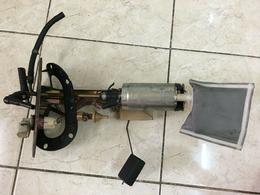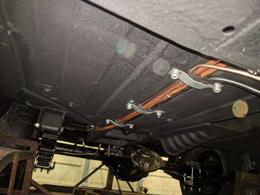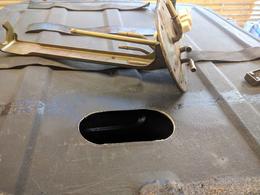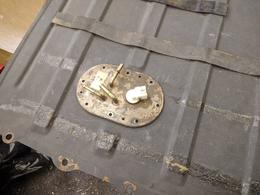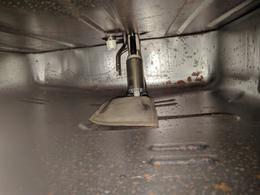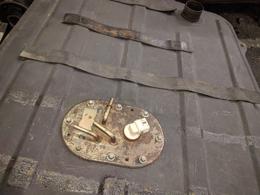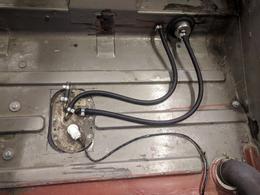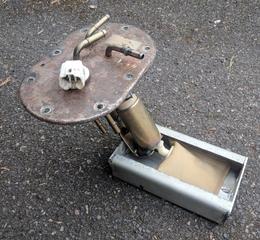Fuel Tank
The fuel tank in an MGB sits below the boot floor and is quite shallow. It’s designed to feed carburettors via a low pressure fuel pump (SU). The tank is not baffled but that’s not a big deal with carbs because the float chamber will buffer a small amount of fuel.
However, this fuel system is entirely unsuitable for a fuel injected engine. The X30XE needs a high pressure fuel pump. The fuel rail runs at 3.0 bar (or 3.8 bar with an updated pressure regulator). The standard X30XE fuel pump supplies 108 litres per hour (lph). In addition, you’ll need an additional fuel line so unused fuel can return to the fuel tank.
There’s 2 ways to make the MGB fuel system suitable for a fuel injected engine. The first way is to use the low pressure pump to lift fuel from the main tank into a small auxiliary tank. This auxiliary tank will contain a high pressure fuel pump which can be used to feed the engine. This has the advantage of not requiring any fuel tank mods and of being less susceptible to fuel starvation but the disadvantage is a much more expensive and complicated setup.
The other way is to mount the high pressure pump directly in the tank. The advantage is that it’s massively cheaper and simpler, but does need you to modify your tank. You also have to make sure that the fuel pickup is not starved of fuel when you accelerate or go around a corner because most MGB tanks are not baffled.
There’s plenty of ways to tackle this problem. You could install an EFI ready tank or modify your own tank to make it EFI ready. I chose to modify my own but I did it slightly differently.
My solution was to use an Impreza WRX fuel pump. These are capable of running at about 180-220lph and provide plenty of pressure. They are also real cheap on eBay (£20-30). The disadvantage is that they don’t have a built-in swirl pot.
In order to fit the fuel pump, I needed to make a few mods to the pump mechanism :-
- Remove the Subaru fuel level sensor. Stick with the existing MGB one.
- The metal mounting arm is too long, so needs shortening.
- The thinnest pipe needs cutting short inside the tank so we can use it as a vent. If you don’t do this, it risks sitting below the fuel level & then if there’s a positive pressure difference inside the tank, it will push fuel out through this hose. Don’t ask me how I know this :)
- An oval hole needs cutting in top of the tank. I chose to put mine in the flat area where the spare wheel boss is. You can use the rubber seal to show you how large the hole needs to be. Be careful to use tools that do not give a spark. I used a drill on a very slow speed to start a hole, then tin snips to finish it.
- I made an oval shaped collar with captive nuts that sits inside the hole, held in place by a few pop rivets. This lets me bolt through the fuel pump flange, through the fuel tank skin & engage in the captive nuts to firmly hold the fuel pump in place against the rubber seal
- Cut a hole in the boot floor to accommodate.
Make sure to identify the feed and return before you mount the pump into the tank so you can plumb them in appropriately. Make sure to pass the feed through a fuel filter to protect your injectors.
The MGB standard vented fuel filler cap allows venting in the outward direction only so any over-pressure in the tank will vent. It does not allow fresh air into the tank to replace the fuel that the engine consumes. I have no idea how this ever worked when the car was running carbs. This means you should utilise the vent pipe in the Subaru fuel pump. DO NOT block it off as shown in my pics below. At the very least, pass it through a 1-way valve and vent to atmosphere so the tank can suck air in as necessary. I’ve taken a slightly different approach and mounted an MX5 carbon canister where the passenger side battery would mount if this were an older car with 2 batteries. For now, I’ve connected the tank vent line to the canister and in future, will connect the canister to the purge valve on the engine.
Another thing to consider is that the MGB tank is not baffled so you’ll get fuel starvation with anything less than 1/3rd of a tank, so the solution is to make the largest baffle / swirl pot that can get through the hole and attach it to the bottom of the fuel pump. With this solution, I can run with the needle pointing to the white line at the bottom of the fuel gauge. I estimate this is ~4 litres in the tank.
Of course, now that you have a fuel pump, you still need to send the fuel to the front of the car. To do this, I used two lengths of 8mm copper gas pipe that I bought from my local hardware supplier. It was bent to shape with a cheap pipe bending tool from eBay.

